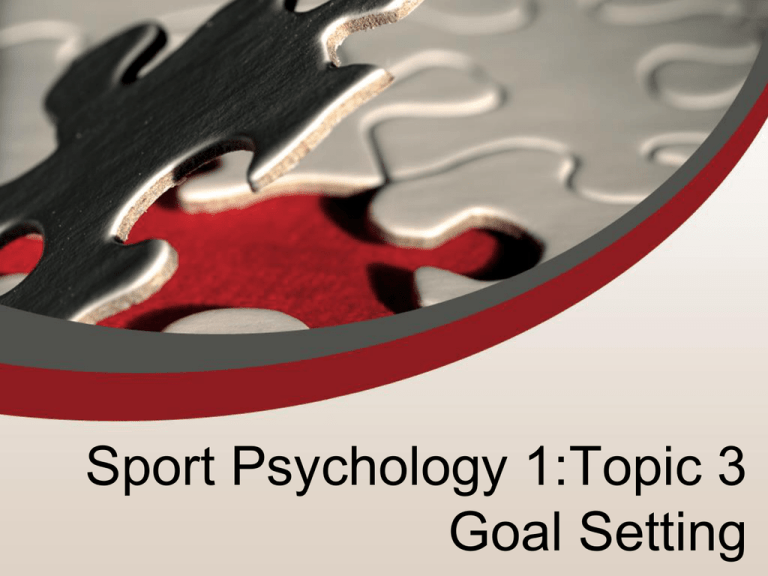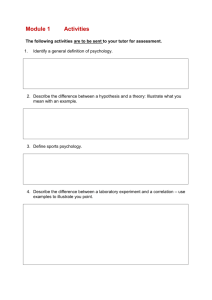Mental Training: Goal Setting
advertisement

Sport Psychology 1:Topic 3 Goal Setting Sport Psychology 1: Motivation • Debrief: – Intensity & Direction: Factors that have to do with their own motivation. • Definition (Factors): (What you have) – – – – – Effort Attitude Goals Ability to sustain commitment Others? • How do you BUILD on these factors? Weinberg & Gould, 2011 Sport Psychology 1: Motivation • Intrinsic – Performance success – Skill improvement – Increased ability to persevere – Emotional control – An opportunity to challenge myself each day – Others?? • Extrinsic – Pride of my coach – Positive recognition from my team mates & friends – Team and League Awards – Post-Secondary/ Provincial opportunities – Others?? Sport Psychology 1:Topic 3 Goal Setting • ACTIVITY: – What do you think of when someone mentions doing a puzzle? – How about when someone mentions completing a puzzle that has: • 10 pieces • 500 pieces • 5000 pieces – What factors change when the number of pieces changes? – Conclusions? How will I know if I have been SUCCESSFUL! Sport Psychology 1:Topic 3 Goal Setting “What do I want to strive for today?” – Goal setting is about mapping out your pathway to success. – Athletes typically understand WHAT goals are • Importance is KEY – HOW commitment is usually measured by coaches, trainers, etc. – Become more COMMITTED. (Yes, this is a GOAL!) (Burton & Weiss, from Horn, 2008;Weinberg, from Van Raalte & Brewer, 2002) Sport Psychology 1:Topic 3 Goal Setting • Key to Goal Setting? – MOTIVATION!! • How do these two topics fit together? – Think about our puzzle! • How do you keep the end produce in mind each day & the outcome? Sport Psychology 1:Topic 3 Goal Setting • Three types of GOALS: – Process: skill performance, task commitment, or measurable outcome under the control of the athlete – Performance: Individual athletes measures independent of the competition, established by the athlete (so greater control), and personal. – Outcome: Focus is on the end-result of the competition, can be dictated by the competition, and not entirely in the control of the athlete. • Athletes should strive to have goals in each category. But, understand that the same level of control does NOT apply to each one! (Weinberg & Butt, from Morris & Terry, 2011) Sport Psychology 1:Topic 3 Goal Setting Examples: Goal Type Poorly written goals Process 1. improve my free throw mechanics Performance 2. improve passing Outcome 3. improve win loss record from last year Rewritten and improved goals 1.focus on bending at the knees during each of 10 trials 2. during each scrimmage, pass to a teammate 8 times 3. Improve free throw percentage during games and decrease the number of fouls in the first half (Monsma, 2007) Sport Psychology 1:Topic 3 Goal Setting Goal setting and Performance: • Goals direct attention towards action. • Goals regulate the amount of effort put into a task. • Motivates athletes to develop alternative strategies to reach the goal. – Have to know WHAT to do WHEN. – Become an “if- than” thinker in order to respond rather than react (Burton & Weiss, from Horn, 2008) Sport Psychology 1:Topic 3 Goal Setting • What gets in the way of achieving our goals (among others)? – – – – – – – Competing interests (priorities) “Spontaneous” goal setting Unhealthy or adversarial competition among teammates Too vague Goals established by others rather than oneself Motivation challenges Others? • Goal setting helps the athlete maintain focus when “adversity” strikes. (Weinberg, from Van Raalte & Brewer, 2002) Sport Psychology 1:Topic 3 Goal Setting Example of 1-2-3 rule: For every OUTCOME goal, you have two PERFORMANCE goals, and three PROCESS goals. Goal Setting for a Quarterback Outcome: 1. To be more competitive with top-tiered teams in our division Performance: 1. 65% completion percentage 2. Release the ball in under 3 seconds. Process 1. Read the defense prior to the snap of the ball. 2. Consistent off-set footwork to improve deception in play action 3. Stand tall & balanced in the pocket on all 3 & 5 step-drops Sport Psychology 1:Topic 3 Goal Setting Collective (team) vs. Individual Goals • Should work together as both are important to performance. What does a COLLECTIVE goal look like with our game? What INDIVIDUAL goals could you set for yourself? Sport Psychology 1:Topic 3 Goal Setting Goal Setting Guidelines & Principles: – Record your goals & make them importance each day! – Need both short & long term goals. – Both practice & competition goals – Be accurate in your own self assessment (recall: SelfAwareness) – Set positive goals (avoid negative language) (Weinberg & Butt, from Morris & Terry, 2011) Sport Psychology 1:Topic 3 Goal Setting • REVIEW: 1. What is the key to Goal Setting? 2. What are the three types of goals? 3. What are two important guidelines to goal setting & WHY are they important? 4. SMARTS Goal Setting Sport Psychology 1:Topic 3 Goal Setting Be SMART when setting goals: • • • • • • S M A R T S be Specific be Measurable be Adjustable be Realistic be Time Bound be Self-Determined






